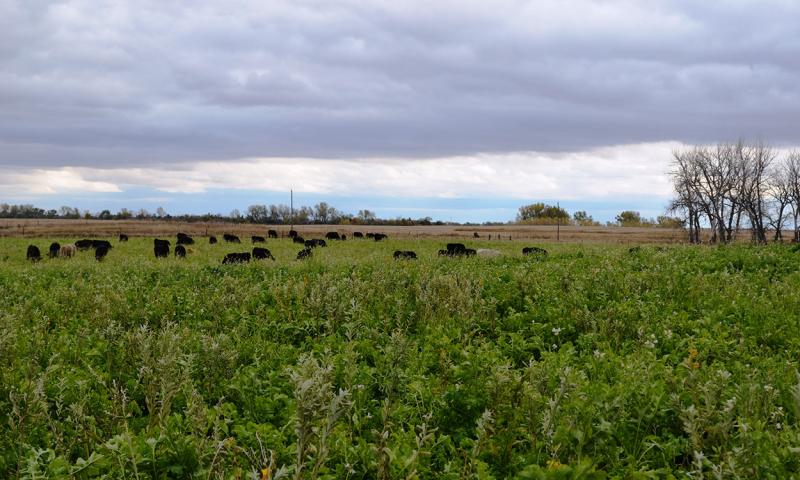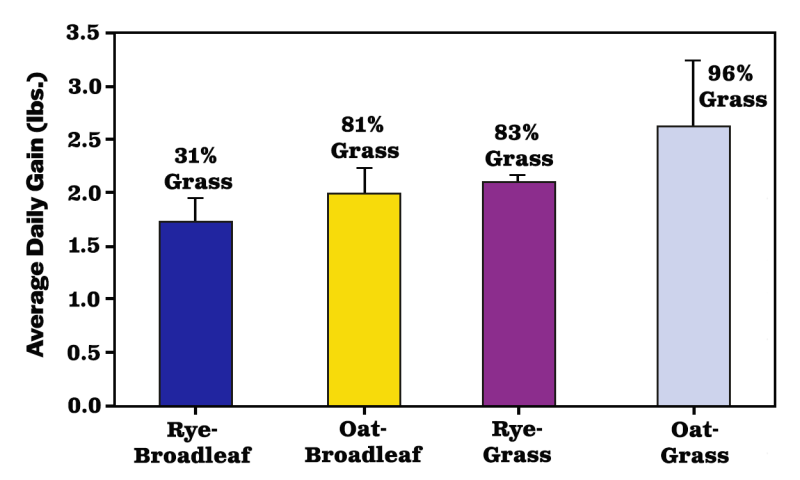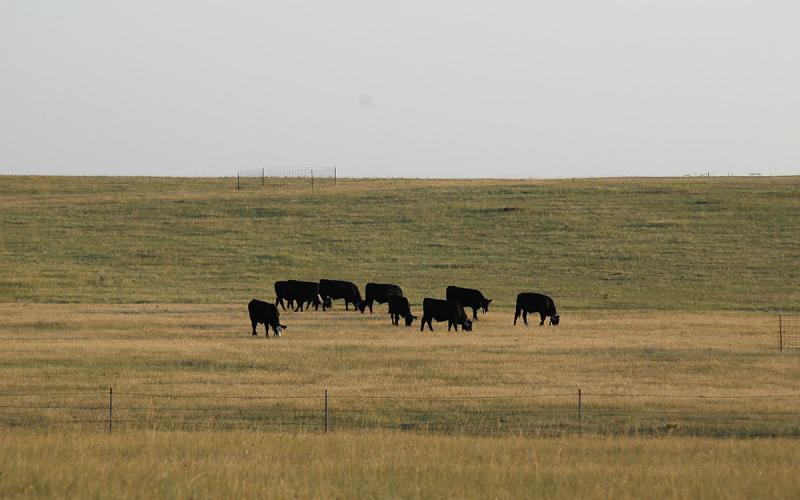Written with contributions by Sydney Vanderhoff, former SDSU Extension Beef Nutrition Field Specialist.
Introduction

With hay prices still high, extending the grazing season is key! Grazing cover crops in the fall and spring can extend the grazing season and reduce feed costs. For fall/winter grazing, selecting cover crops that are winter-killed in South Dakota environments are preferred; whereas, for spring grazing, species that can overwinter are ideal. Selection of cover crop species is dependent on time of planting. Growing after small grain harvest (usually late July through early August) for fall/winter grazing provides an ample seasonal window to select species from a wide range. Common cover crop species used after small grains are brassicas (radish, turnip, rapeseed), grasses (oat, barley, millet, sorghum sudangrass) and legumes (vetch, chickpea, sun hemp, lentil, pea). The overwintering species generally used in South Dakota are winter cereals, such as winter rye, winter triticale, and winter wheat. In some cases, these winter cereals (especially rye) can be grazed both in the fall and spring depending on weather, grazing management, and regrowth potential.
Considerations Before Planting
Turnips and radishes are common brassicas grown in the Midwest; with adequate moisture, they produce high-quality forage ranging from 15 to 20% crude protein and 60 to 70% TDN. However, high moisture content in these species can limit dry matter consumption and affect performance (Figure 1). The roots, stems, and leaves of the brassicas are all palatable to cattle. When grazing turnips or radishes, cattle should have access to lower-quality hay to provide them with adequate amounts of fiber, which will help prevent bloat. Due to high sulfur content, cattle may not prefer brassicas right away and may need acclimation to grazing.

Planting a cover crop mixture creates selection for cattle as well as greater biological activity below ground, increased ground cover, and improved nutrient cycling, all contributing to building up soil health. Planting timing is a factor to consider as well. Warm-season cover crop species should ideally be planted anytime during the early-to-mid summer, but ideally no later than the first week of August. Cool-season cover crops should be planted approximately the third week of July, as average daily temperature tends to decrease due to lower nighttime temperatures at this time. Following small grain cash crop harvest, mixtures with both warm and cool-season species may thrive, even if the planting window is not ideal for both; however, it’s important to note that warm-season covers planted late in the season may not have adequate growth prior to any early frost.
Risks to Consider
Some species of cover crops have potential to be toxic to cattle. Common toxicities with cover crops include prussic acid, nitrates, and sulfur. Forage sorghum, sudangrass, and sorghum hybrids may experience prussic acid build-up and release in the leaves and stems following a frost, as they are very susceptible to cold temperatures.1 Generally, it is recommended to keep cattle out of fields planted to mixes that contain a higher proportion of these grasses for about a week immediately following a frost event to let the prussic acid dissipate. In addition, nitrates may accumulate in cereal grain forages (especially oats), sorghum, sudangrass, and corn, dependent upon soil fertility management and environmental conditions. Accumulation is typically associated with drought stress, with greater concentration on lower plant parts. Forage tests are important to check prussic acid and nitrate levels, as well as forage quality. See Table 1 for cover crop options for grazing.
| Prior Crop | Cover Crop Family | Species | Grazing Period | Advantages | Disadvantages |
|---|---|---|---|---|---|
| Corn, corn silage, sweet corn, soybeans | Winter annual cereals | Rye, triticale, wheat | Spring | Winter cover, high biomass | Higher potential for soil compaction in spring grazing |
| Corn, corn silage, sweet corn, soybeans | Brassicas | Winter camelina | Spring | Winter cover, germinates down to 32 degrees F | Higher potential for soil compaction in spring grazing, low biomass compared to cereals, cover can be spotty in spring |
| Wheat | Winter annual cereals | Rye, triticale, wheat | Fall, spring | Winter cover, high biomass | Higher potential for soil compaction in spring grazing |
| Wheat | Cool-season annual grasses | Oats, barley, annual ryegrass | Fall | High biomass | Winterkills |
| Wheat | Summer annual grasses | Forage sorghum, sorghum-sudangrass, pearl millet | Fall | High biomass | Prussic acid toxicity (sorghums and sudangrasses), winterkills |
| Wheat | Brassicas | Turnip, radish, collard, kale, rape | Fall | High forage quality, high biomass | Winterkills, low fiber (NDF), should not constitute more than 70% of diet |
| Wheat | Legumes | Red, white, crimson and berseem clover; winter and field peas | Fall, spring (red clover) | High protein, potential nitrogen credit to following crop | Low biomass, potential for bloat from red, white, crimson and peas |
Source: Grazing cover crops to preserve stored feed, University of Wisconsin-Madison
Application
A trial conducted at the University of Nebraska-Lincoln2 reported that cover crops, such as cereal rye, winter triticale, or winter wheat, were best for early spring grazing. They evaluated the three species as a double-cropped forage in a continuous soybean rotation and reported minimal differences in early spring grazing potential and animal performance across species. However, cereal rye did offer an advantage when freezing conditions occur after early spring turnout of calves in the field.
Sources
- Barnhart, S. 2011. Prussic Acid Poisoning Potential in Frosted Forages. Prussic Acid Poisoning Potential in Frosted Forages | Integrated Crop Management (iastate.edu)
- Hall, A.K., A. M. Sartin, K. J. Calus, M. T. Grabau, D. D. Redfearn, R. B. Mitchell, M. E. Drewnoski. 2024. Cereal Rye, Winter Triticale, or Winter Wheat. Nebraska Beef Report. 42-44


